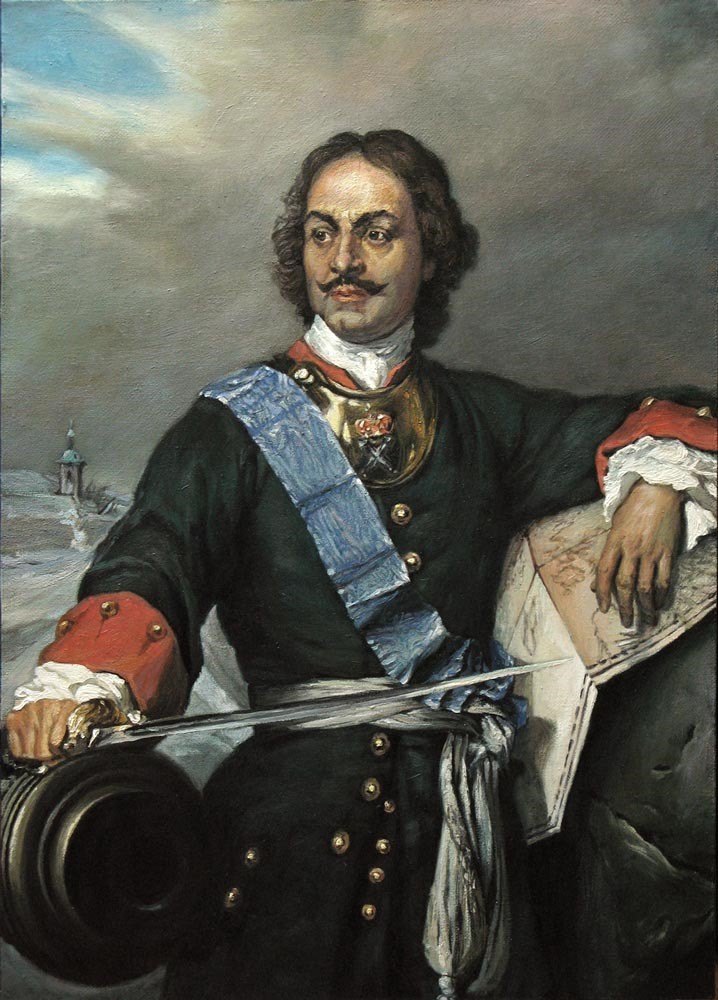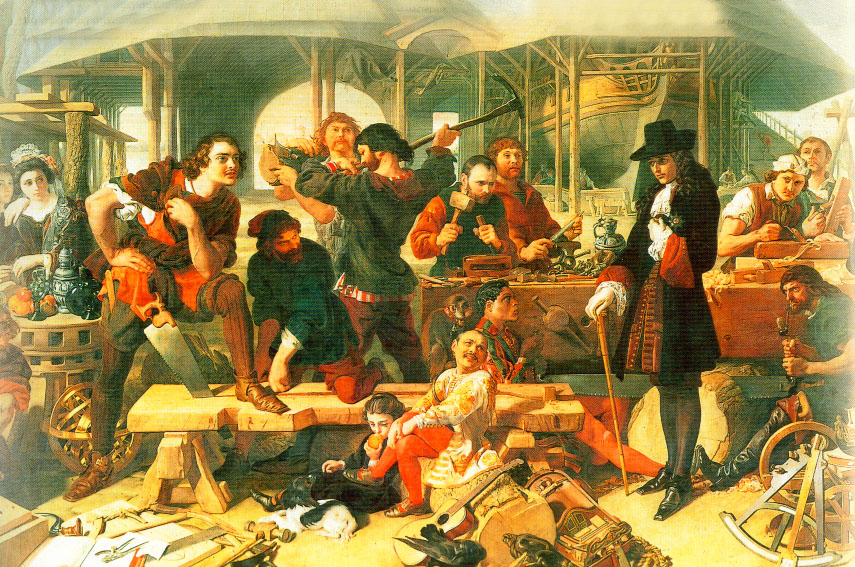Who is Tsar Peter I (Peter the Mad)?
Who is Tsar Peter I (Peter the Mad)?
Pyotr Alekseyevich, Tsar Peter I or as he was known in Turkish history, Peter the Crazy. The reign of Tsar Peter, who ruled Russia between 1689 and 1725, is considered a critical turning point in Russian history in terms of the modernization of Russia, especially the development of the Russian army and navy, and Russia's turn towards an expansionist and aggressive foreign policy.
His birth and becoming tsar
Tsar Peter I (Peter the Mad) was born in Moscow in June 1672, as the son of Russian Tsar Alexei I of the Romanov Dynasty. He ascended to the throne upon the death of his father in May 1682, but since he was 10 years old, his half-sister Sofia Alekseyevna took over the power as regent.
During this period, Petro was completely removed from the administration and lived with his mother in the newly established German quarter in Moscow. Here, Peter, who was greatly influenced by the Germans and learned new information, began to form his opinions that Russia should be Europeanized.
Also during this period, when she was only 14 years old, she was forced to marry by her mother, and her son Aleksey was born the following year. But Peter never got along with his first wife. In 1689, with a palace coup, Peter took power from his sister. While Peter's mother became the regent, this time the management was mainly in the hands of Peter, not the regent. After his mother's death in 1694, the administration completely passed to Peter.
Goal of landing in warm seas
During this period, the Russian Tsardom had no access to the high seas. Since the Ottoman Empire closed the Black Sea and Sweden closed the Baltic Sea to Russia, Russia only had access to the Arctic Ocean, which could not be used sufficiently due to cold and glaciers.
Aiming for Russia to reach the warm seas, Peter decided to defeat Sweden and the Ottoman Empire, which were militarily superior to Russia at that time. Bringing in military experts from Europe, especially German and British, Peter embarked on a move to modernize the army. He also went on a European tour and observed the developments in Europe on site. It is stated that during this period, Petro even worked on ships at lower levels and observed current developments and technology.
Although Peter's main goal was military development, he also embarked on a project to culturally Europeanize the Russians towards this goal. He ordered European clothes to be worn and beards to be shortened.
After the Vienna defeat, European states formed an alliance and declared war on the Ottoman Empire. Seeing this as an opportunity, Peter joined this alliance even though it was a Catholic religious alliance and Russia was Orthodox. Peter's aim was to capture the Azov Castle, at the cape of the Sea of Azov opening to the Black Sea, which was in the hands of the Ottoman Empire.
After an unsuccessful attempt, Peter captured the Azak Castle in 1696 as a result of an attack by land and river navy ships. With the Treaty of Istanbul signed between the Ottoman Empire and the Russian Tsardom in 1700, the Ottoman Empire accepted the transfer of Azov to the Russian Tsardom. Thus, Peter reached the warm seas for the first time.
Victory over Sweden and Battle of Prut with the Ottomans
Also in 1700, Prussia, Denmark-Norway and Poland declared war on Sweden, which was seen as the greatest power in the region. Peter saw this war as an opportunity to eliminate the Swedish threat to Russia and for Russia to reach the Baltic Sea, and joined the alliance fighting against Sweden.
The war initially continued with Russia's defeat. In 1708, Swedish King Karl 12 went on an expedition to Russia. Since the army of Karl, who did not take the Russian army seriously, was small, in 1709, Tsar Peter's army defeated the army of Karl 12 in Poltova, which is in today's Ukraine.
Charles XII advanced south with the remains of his army, took refuge in Ottoman lands, and made an alliance with the Ottoman Empire against Russia. As a result of the insistence of Karl 12, the Ottoman Empire declared war on Russia in 1710.
In 1711, near the Prut River, the Ottoman army of 120 thousand people surrounded the Russian army of 40 thousand people, including Tsar Peter. Charles XII, who participated in this expedition, saw this as an opportunity and proposed the destruction of Tsar Peter and the Russian army. Arguing that this would be easy, Charles XII stated that if this was achieved, the Russian threat would be completely over.
However, Grand Vizier Baltacı Mehmet Pasha, who was at the head of the Ottoman army, accepted Tsar Peter's peace offer, considering the possibility of not winning the war. It was agreed to allow Tsar Peter to withdraw with his army in exchange for the return of the Azov Castle to the Ottomans. Thus, Petro had to postpone his projects for the Black Sea.
When Baltacı Mehmet Pasha returned to Istanbul for this decision, he was highly criticized, dismissed and exiled. Tsar Peter, who overcame this crisis and secured the Ottoman front with a peace agreement, went to war with Sweden and captured the Baltic coast with the support of other countries fighting against Sweden.
Founding of Saint Petersburg
Tsar Peter founded a new city named Saint Petersburg on this coast he captured from Sweden and moved the capital of the country here from Moscow. The use of the German version of the name Peter, Peter, also showed Tsar Peter's admiration for Germany.
Since peasants in Russia were considered slaves until 1861, by the order of Peter, tens of thousands of peasants were made to work in the construction of Saint Petersburg under extremely bad and difficult conditions.
In 1721, the Northern War ended with Sweden accepting its defeat, and Sweden accepted the transfer of the lands captured by Russia to Russia. After this victory, Tsar Peter declared himself emperor.
Iranian expedition
In the same period, Tsar Peter, who wanted to take advantage of Iran's internal turmoil, went on an expedition to Iran in 1722. His aim was to capture Iran's Caspian Sea coast. Taking advantage of Iran's turmoil, the Russian army gained victories and advanced along the western shores of the Caspian Sea, reaching Iran's Geylan Province on the southern shores of the Caspian Sea in 1723.
With the Treaty of Saint Petersburg signed between Iran and Russia in 1723, the western coasts of the Caspian Sea were given to Russia. After Tsar Peter, in the 1730s, Iran would take back these lands from Russia.
His death and its significance in Russian history
Peter, who fell ill during the Persian expedition, died in February 1725 before completing his plan to invade Central Asia. His eldest son, Alexei, was tortured to death on his father's orders in 1690, on the charge of trying to overthrow his father, and was succeeded by his wife, Catherine I.
Tsar Peter is considered a critical turning point in Russian history in terms of the modernization of Russia, especially the development of the Russian army and navy, and Russia's turn towards an expansionist and aggressive foreign policy.
In the later period of the 18th century, Russia decisively defeated its enemies, especially the Ottoman Empire, and expanded. The works during the reign of Tsar Peter had a great impact on the country being seen as the third largest power in the world after England and France in the last quarter of the century.
































